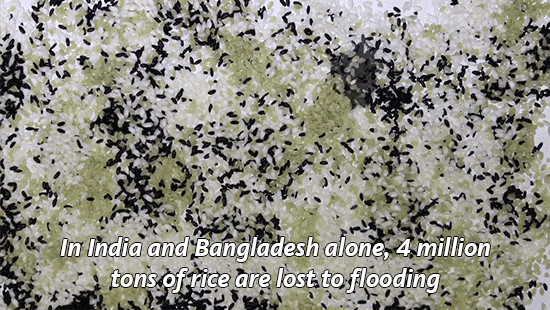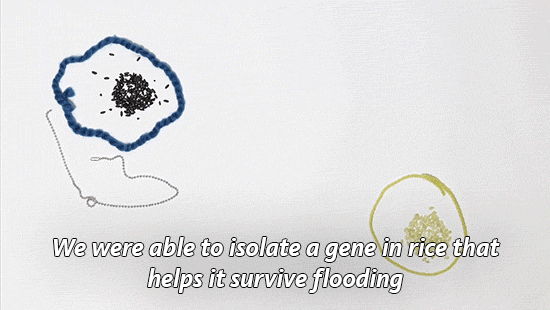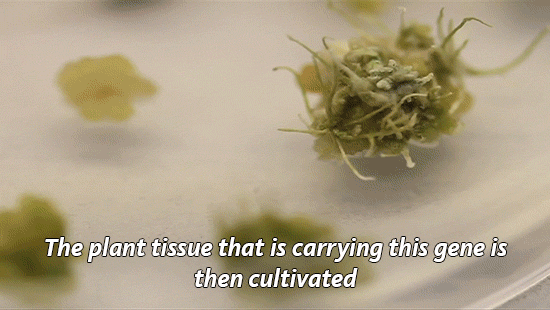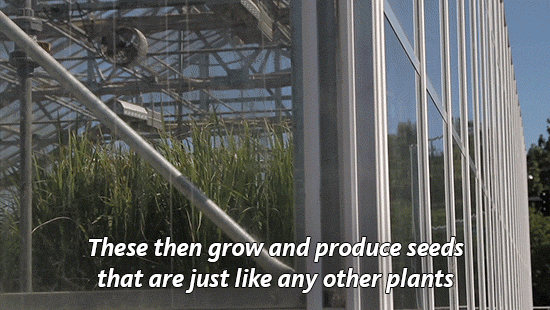Programming
programming
More Posts from Science-is-magical and Others




Why we need GMOs to survive climate change
Genetically modified organisms get a bad rap for many reasons, but we’ve actually been genetically altering what we eat since the dawn of human history.
“For 10,000 years, we have altered the genetic makeup of our crops,”explains UC Davis plant pathology professor Pamela Ronald.
“Today virtually everything we eat is produced from seeds that we have genetically altered in one way or another.” (You can read more about Ronald’s thoughts on genetically engineered food here.)
Right now her focus is on rice. It’s one of our basic crops and without it, we would struggle to feed much of the world.
With climate change, we’re seeing an increase in flooding in places like India and Bangladesh, which makes it harder to grow this important food staple.
So Ronald and her lab have developed a flood-tolerant strain of rice. It’s known as Sub1a or “scuba rice” and millions of farmers in South Asia are now growing it in their fields.

Today is National Food Day, a day dedicated to hunger awareness. But as we focus on food insecurity, we need to talk more about how global warming will make the problem worse.
As our climate continues to heat up, it has huge impacts on what foods we are able to grow. Will our crops be able to survive droughts and floods? The University of California leads six labs that are working to develop other climate-resilient crops including chickpea, cowpea and millet.
Find out what other scientists are doing to improve our food.
Total breakdown in the brain
A stroke is just one example of a condition when communication between nerve cells breaks down. Micro-failures in brain functioning also occur in conditions such as depression and dementia. In most cases, the lost capacity will return after a while. However, consequential damage will often remain so that the functional capability can only be restored through lengthy treatment — if at all. For this reason, researchers at Friedrich-Alexander-Universität Erlangen-Nürnberg (FAU) have been investigating what happens during such breakdown phases and looking at possible ways of preventing damage and speeding up the healing processes. Their findings have been recently published in the eminent journal Scientific Reports.

(Image caption: Nerve cell networks visualised using high-speed fluorescent microscopy and then reconstructed with the software developed by Wrosch and her team. Credit: FAU/Jana Wrosch)
The research team headed by Jana Wrosch of FAU’s Chair of Psychiatry and Psychotherapy found that significant alterations occurred in neural cells while the communication pathways were blocked. Neuron networks reconnect during such periods of inactivity and become hypersensitive. If we imagine that normal communication pathways are motorways, when they are blocked a form of traffic chaos occurs in the brain whereby information is re-routed in disorganised form along what can be called side streets and minor routes. Additional synapses are generated everywhere and begin operating. When the signal is reinstated, the previously coordinated information routes no longer exist and, as in the case of a child, the appropriate functions need to be learned from scratch. Since they are receiving no normal signals during the phase of brain malfunction, the nerve cells also become more sensitive in an attempt to find the missing input. Once the signals return, this means they may overreact.
Nerve cells flicker when stained
Visualising the microscopically minute connections between the nerve cells is a major technical challenge. The conventional microscopic techniques currently available, such as electron microscopy, always require preliminary treatment of the nerve cells that are to undergo examination. However, this causes the nerve cells to die, so that the alterations that occur in the cells cannot be observed. To get round this problem, Wrosch and her team have developed a high-speed microscopy process along with special statistical computer software that make it possible to visualise the communication networks of living neurons. First, a video of the cells is made whereby an image is taken every 36 milliseconds. A special dye is used to stain the cells to ensure that the individual cells flicker whenever they receive a signal. Subsequently, the software recognises these cells on the video images and detects the information pathways by which the signals are transmitted from cell to cell.
The nerve cells are then exposed to the pufferfish poison tetrodotoxin to simulate the blocking of communication channels that occurs in disorders. After inducing communication breakdown phases of varying lengths, the researchers remove the toxin from the cells and determine how the nerve cell networks have changed during exposure. ‘Thanks to this concept, we have been finally able to discover what happens when communication is blocked,’ explains Wrosch. ‘Now we can try to develop medications that will help prevent these damaging changes.’ In future projects, the research team plans to examine the exact mode of action of anti-depressants on nerve cell networks and intends to find new approaches to creating more effective drugs.
Whenever someone tries to claim that evolution is a lie, I send them a picture of platybelodon.

1. It’s an excellent example of transitional evolution.
2. It’s a mess who would intentionally do this and why
3. It makes them piss themselves a little.
“Evolution is just a theory-”


Slime mold was grown on an agar gel plate shaped like America and food sources were placed where America’s large cities are.
The result? A possible look at how to best build public transportation.
I just really like the idea of slime mold on a map of the US. It’s beautiful.
I'm pretty new here, and I don't actually know much about dinosaurs (just followed this blog because it seemed really cool and interesting) so could you explain what shrink-wrapped means?
Of course! See, modern animals have a lot of muscles, fat, fluff, etc, and end up looking very little like their actual skeleton. For example, look at how much fluff owls have:

(Source)
However, lots of palaeoartists completely ignore this! They basically stretch skin over the bones and call it a day. One especially bad example that was featured on @palaeofail is this poor pterosaur:

It barely has room for its digestive system. It’s definitely missing the air sac system that allows it to breathe. It’s got virtually no muscles on the arms - how does it fly?? - on the head (no wonder its mouth is open. It has no jaw muscles to close it!), on the torso (it needs to flap), or on the legs (walking) It doesn’t have any fat at all, so it’s definitely starving (maybe because it can’t fly or close its moth?). The skin is much too thin; you can see all of the bones and its wing membranes should be much, much thicker. And it’s missing the hair-like pycnofibres that should be covering its body!
Many palaeoartists have started to strike back at this by drawing modern animals like we might draw them if we found their bones:

(Source)
[House cat]


(Source)

(Image caption: In this illustration, a pair of eyeglasses “resolves” distinct serotonin neuron subtypes (shown as brightly colored cells) on a simple map of a region called the raphe in the mouse brain. By viewing serotonin neurons through multiple “lenses”—such as single-neuron and population-scale global gene expression, developmental lineage and anatomy—researchers have revealed diverse subtypes and principles of subtype organization in the brain. Credit: Mallory Rice)
Time for a New Definition
It used to be enough to call a serotonergic neuron a serotonergic neuron.
These brain cells make the neurotransmitter serotonin, which helps regulate mood, appetite, breathing rate, body temperature and more.
Recently, however, scientists have begun to learn that these neurons differ from one another—and that the differences likely matter in dysfunction and disease.
Last year, a team led by Harvard Medical School genetics professor Susan Dymecki defined a subgroup of serotonergic neurons in mice by showing that those cells specifically, among all serotonergic neurons, were responsible for increasing the breathing rate when too much carbon dioxide builds up in the body.
Now, Dymecki and colleagues have taken a first stab at systematically characterizing serotonergic neurons at the molecular level and defining a full set of subtypes, again in mice.
The researchers report in Neuron that serotonergic neurons come in at least six major molecular subtypes defined by distinct expression patterns of hundreds of genes. In many cases, the subtypes modulate different behaviors in the body.
By conducting a cross-disciplinary series of experiments, the researchers found that the subtypes also vary in their developmental lineage, anatomical distribution, combinations of receptors on the cell surface and electrical firing properties.
“This work reveals how diverse serotonin neurons are at the molecular level, which may help to explain how, collectively, they are able to perform so many distinct functions,” said Benjamin Okaty, a postdoctoral researcher in the Dymecki lab and co-first author of the paper.
“To have the list of molecular players that make each of these subtypes different from one another gives us an important handle on learning more about what that cell type does and how we can manipulate only that subtype,” said Dymecki. “It holds enormous therapeutic potential.”
“This is an ancient neurotransmitter system that’s implicated in many different diseases, and it’s starting to be cracked open,” said Morgan Freret, a graduate student in the Dymecki lab and co-first author of the paper. “We can now ask questions in a more systematic way about which serotonergic cells and molecules are important in, for example, pain, sleep apnea or anxiety.”
Crucially, the team also showed that a serotonergic neuron’s gene expression and function depend not only on its location in the adult brain stem, but also on its cellular ancestor in the developing brain.
“Earlier work had shown that you could explore the relationship between a mature neuronal system and the different developmental lineages that gave rise to it, but we had no idea whether it was meaningful,” said Dymecki. “We show that the molecular phenotypes of these neurons track quite tightly to their developmental origin, with anatomy making some interesting contributions as well.”
While the work was done in mice, Dymecki is optimistic that it will be replicated in humans because the serotonergic neuronal system is in a highly conserved region of the brain, meaning it tends to remain consistent across vertebrate species.
Because of this, researchers can look for the same molecular signatures in human tissue and begin to tease apart whether particular subtypes of serotonergic neurons are involved in conditions such as sudden infant death syndrome (SIDS) or autism.
Such research could ultimately reveal previously unknown contributions of the serotonergic neuronal system to disease, inform the development of biomarkers or lead to more targeted therapies.
The team’s findings could also inform stem cell research. “Which subtype of serotonergic neuron are we getting when we use current stem cell protocols?” asked Dymecki. “Can we drive the development of different subtypes? Can we watch how gene expression patterns change over time during development for each subtype?”
Finally, the study provides an example of a highly integrative approach to understanding brain function at multiple scales, “linking genes and gene networks to the properties of single neurons and populations of neuron subtypes, all the way up to the level of animal behaviors,” said Okaty. “I think it’s a useful template going forward. Imagine what we’d learn by applying this approach to all the neurotransmitter systems in the brain.”

A dash of graphene can transform the stretchy goo known as Silly Putty into a pressure sensor able to monitor a human pulse or even track the dainty steps of a small spider1.
The material, dubbed G-putty, could be developed into a device that continuously monitors blood pressure, its inventors hope. It also demonstrates a form of self-repair that may herald smarter graphene composites.
Since graphene was first isolated in 2004, researchers have added these atom-thin sheets of carbon to a panoply of different materials, hoping to create composites that benefit from its superlative strength and electrical conductivity. But there have been surprisingly few attempts to blend it with ‘viscoelastic’ materials such as Silly Putty, which behaves as both an elastic solid and a liquid. Leave a lump on top of a hole, for example, and it will slowly ooze through.
Conor Boland, a researcher working in Jonathan Coleman’s nanotechnology lab at Trinity College Dublin, wondered what would happen if he brought the two materials together. “I’d like to be able to say it was carefully planned, but it wasn’t,” laughs Coleman. “We’ve just got a tradition in my group of using household stuff in our science.” (In 2014, his team found that they could make graphene by blitzing graphite in a kitchen blender2).
Continue Reading.
-
 aceascake reblogged this · 1 year ago
aceascake reblogged this · 1 year ago -
 eriboob liked this · 4 years ago
eriboob liked this · 4 years ago -
 caniisvulpes reblogged this · 4 years ago
caniisvulpes reblogged this · 4 years ago -
 aceascake reblogged this · 4 years ago
aceascake reblogged this · 4 years ago -
 anarcho-decepticonism reblogged this · 4 years ago
anarcho-decepticonism reblogged this · 4 years ago -
 aceascake liked this · 4 years ago
aceascake liked this · 4 years ago -
 anarcho-decepticonism reblogged this · 4 years ago
anarcho-decepticonism reblogged this · 4 years ago -
 aceascake reblogged this · 5 years ago
aceascake reblogged this · 5 years ago -
 cupidsfall liked this · 6 years ago
cupidsfall liked this · 6 years ago -
 willlowed reblogged this · 6 years ago
willlowed reblogged this · 6 years ago -
 lostlight reblogged this · 6 years ago
lostlight reblogged this · 6 years ago -
 anarcho-decepticonism reblogged this · 6 years ago
anarcho-decepticonism reblogged this · 6 years ago -
 science-is-magical reblogged this · 6 years ago
science-is-magical reblogged this · 6 years ago -
 deaughh reblogged this · 6 years ago
deaughh reblogged this · 6 years ago -
 deaughh liked this · 6 years ago
deaughh liked this · 6 years ago -
 cedarsaga reblogged this · 6 years ago
cedarsaga reblogged this · 6 years ago -
 ghostcl0wn reblogged this · 6 years ago
ghostcl0wn reblogged this · 6 years ago -
 marmalade-and-sugarsongs liked this · 6 years ago
marmalade-and-sugarsongs liked this · 6 years ago -
 moonlightsblade reblogged this · 7 years ago
moonlightsblade reblogged this · 7 years ago -
 ghostcl0wn liked this · 7 years ago
ghostcl0wn liked this · 7 years ago -
 harpylady liked this · 7 years ago
harpylady liked this · 7 years ago -
 phq9 reblogged this · 7 years ago
phq9 reblogged this · 7 years ago -
 silvercorvidking liked this · 7 years ago
silvercorvidking liked this · 7 years ago -
 betternameplox liked this · 7 years ago
betternameplox liked this · 7 years ago -
 nightapproaches reblogged this · 7 years ago
nightapproaches reblogged this · 7 years ago -
 nightapproaches liked this · 7 years ago
nightapproaches liked this · 7 years ago -
 bidonut-blog liked this · 7 years ago
bidonut-blog liked this · 7 years ago -
 loudroaringseas reblogged this · 7 years ago
loudroaringseas reblogged this · 7 years ago -
 okinawabearsnake reblogged this · 7 years ago
okinawabearsnake reblogged this · 7 years ago -
 cosmicporo reblogged this · 7 years ago
cosmicporo reblogged this · 7 years ago -
 finnspersonal reblogged this · 7 years ago
finnspersonal reblogged this · 7 years ago -
 yourenotgonnafindme reblogged this · 7 years ago
yourenotgonnafindme reblogged this · 7 years ago -
 glassofpumpkinjuice liked this · 7 years ago
glassofpumpkinjuice liked this · 7 years ago -
 nekukuku liked this · 7 years ago
nekukuku liked this · 7 years ago -
 spookblem liked this · 7 years ago
spookblem liked this · 7 years ago -
 peedmyfursuit liked this · 7 years ago
peedmyfursuit liked this · 7 years ago -
 you-had-me-at-helloworld liked this · 7 years ago
you-had-me-at-helloworld liked this · 7 years ago -
 strangetastes reblogged this · 7 years ago
strangetastes reblogged this · 7 years ago -
 toychimera reblogged this · 7 years ago
toychimera reblogged this · 7 years ago -
 boomimfired reblogged this · 7 years ago
boomimfired reblogged this · 7 years ago -
 smokeybones reblogged this · 7 years ago
smokeybones reblogged this · 7 years ago -
 yeeuurhnghghh reblogged this · 7 years ago
yeeuurhnghghh reblogged this · 7 years ago -
 yeeuurhnghghh liked this · 7 years ago
yeeuurhnghghh liked this · 7 years ago -
 stinkbeck liked this · 7 years ago
stinkbeck liked this · 7 years ago -
 manicpixievideovixen liked this · 7 years ago
manicpixievideovixen liked this · 7 years ago








